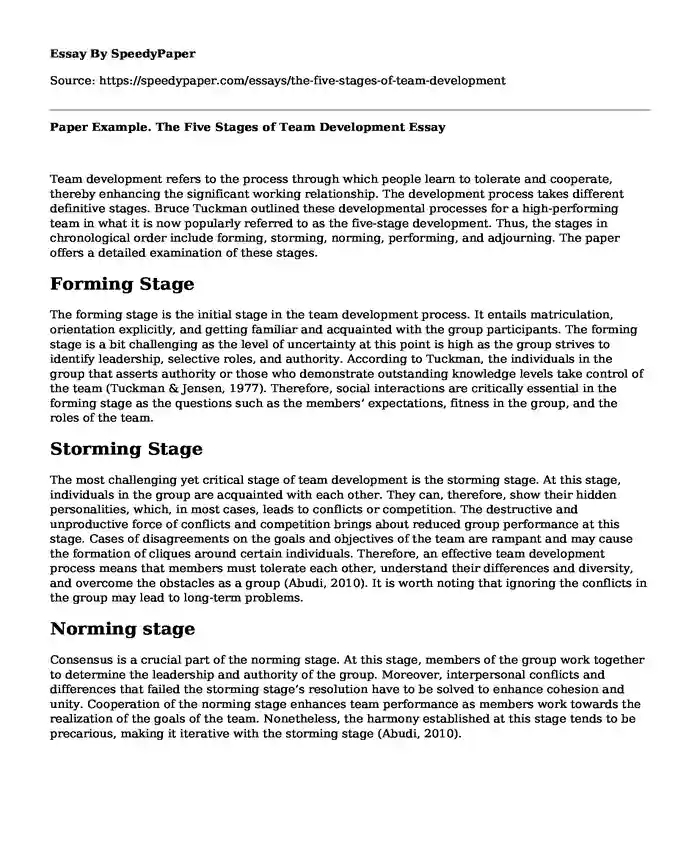
| Type of paper: | Essay |
| Categories: | Human resources Professional development Interpersonal communication |
| Pages: | 3 |
| Wordcount: | 710 words |
Team development refers to the process through which people learn to tolerate and cooperate, thereby enhancing the significant working relationship. The development process takes different definitive stages. Bruce Tuckman outlined these developmental processes for a high-performing team in what it is now popularly referred to as the five-stage development. Thus, the stages in chronological order include forming, storming, norming, performing, and adjourning. The paper offers a detailed examination of these stages.
Forming Stage
The forming stage is the initial stage in the team development process. It entails matriculation, orientation explicitly, and getting familiar and acquainted with the group participants. The forming stage is a bit challenging as the level of uncertainty at this point is high as the group strives to identify leadership, selective roles, and authority. According to Tuckman, the individuals in the group that asserts authority or those who demonstrate outstanding knowledge levels take control of the team (Tuckman & Jensen, 1977). Therefore, social interactions are critically essential in the forming stage as the questions such as the members’ expectations, fitness in the group, and the roles of the team.
Storming Stage
The most challenging yet critical stage of team development is the storming stage. At this stage, individuals in the group are acquainted with each other. They can, therefore, show their hidden personalities, which, in most cases, leads to conflicts or competition. The destructive and unproductive force of conflicts and competition brings about reduced group performance at this stage. Cases of disagreements on the goals and objectives of the team are rampant and may cause the formation of cliques around certain individuals. Therefore, an effective team development process means that members must tolerate each other, understand their differences and diversity, and overcome the obstacles as a group (Abudi, 2010). It is worth noting that ignoring the conflicts in the group may lead to long-term problems.
Norming stage
Consensus is a crucial part of the norming stage. At this stage, members of the group work together to determine the leadership and authority of the group. Moreover, interpersonal conflicts and differences that failed the storming stage’s resolution have to be solved to enhance cohesion and unity. Cooperation of the norming stage enhances team performance as members work towards the realization of the goals of the team. Nonetheless, the harmony established at this stage tends to be precarious, making it iterative with the storming stage (Abudi, 2010).
Performing stage
The performing stage involves constructive dealing with emerging conflicts to enhance cooperation in the group. The stage is relatively smooth as it entails a mature, well-structured, organized, and well-functioning unit (Roy, 2019). The structure of the group, at this stage, is clear and stable, leading to commitment towards achieving the missions of the team. Therefore, the team is focusing more on the performance of the group by dealing with problems and meeting the team’s objectives.
Adjourning stage
The adjourning stage is the last step in the team development process. It operates in an environment where the group has accomplished the goals and objectives of the team. Thus, the emphasis of the group at this stage is to wrap up the available tasks and document the findings and results. The stage ushers in disbandment and forming stage for new groups in case there are reshuffles or the group has realized their ultimate goal (Tuckman & Jensen, 1977). The stages appear as behaviors in the healthcare situation where physicians or clinicians create teams to deal with emerging health issues. These could be groups formed to deal with emergency health services. The group works together in dealing with such an issue.
References
Abudi, G. (2010). The Five Stages of Team Development: A Case Study. Project Management, Project Smart. Retrieved on September 01, 2020, from https://www.yhqyangta.com/pdf/the-five-stages-of-team-development-a-case-study.pdf
Roy, L. T. (2019). A Team approach to professional development and accountability. Journal of Nuclear Medicine Technology, 47(4), 332-335. Retrieved on September 01, 2020, from https://scholar.google.com/scholar?output=instlink&q=info:keOicFOOPPsJ:scholar.google.com/&hl=en&as_sdt=0,5&as_ylo=2016&scillfp=3527762858400333231&oi=lle
Tuckman, B. W., & Jensen, M. A. C. (1977). Stages of small-group development revisited. Group & Organization Studies, 2(4), 419-427. Retrieved on September 01, 2020, from http://faculty.wiu.edu/P-Schlag/articles/Stages_of_Small_Group_Development.pdf
Cite this page
Paper Example. The Five Stages of Team Development. (2023, Nov 27). Retrieved from https://speedypaper.com/essays/the-five-stages-of-team-development
Request Removal
If you are the original author of this essay and no longer wish to have it published on the SpeedyPaper website, please click below to request its removal:
- Visiting Tom Davis Factory in China - Personal Experience Essay Example
- Information technology research paper
- Essay Sample on Work-Based Assessment
- Essay Sample on Basis of Competitive Advantage in the Industry
- Free Essay on Screening Guidelines: Mammogram
- Free Essay Sample. Parental Absence
- Free Essay: The Urgency of Intersectionality- Annotated Bibliography
Popular categories




